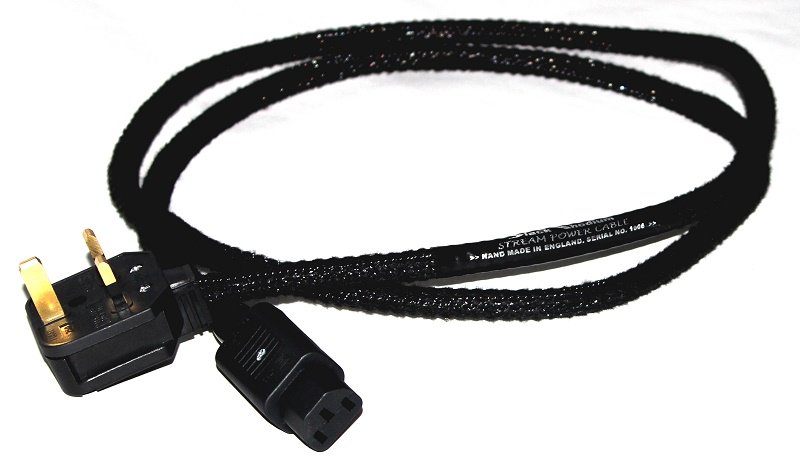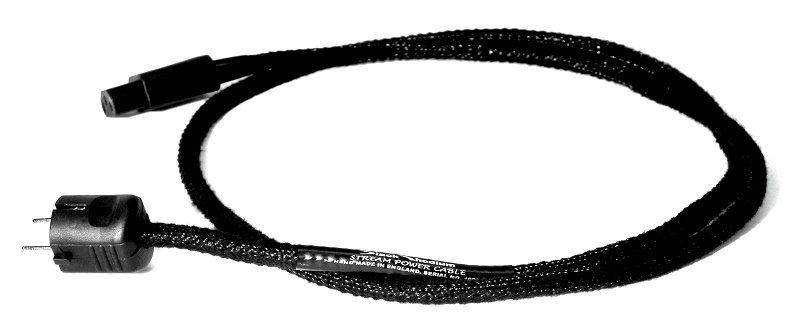Janine Elliot takes a listen to the Black Rhodium Stream Power cable costing £450 for a 1.7m length…and it’s that length the designer believes to be important.
Reviewing interconnects and speaker cables will inevitably be accompanied with misbelief from a number that cables can ever make any differences to the sound of your hifi. I have even heard that personally from a few ex-manufacturing friends, ‘ex’ being the operative word. To be given a mains cable for reviewing is even more likely to carry that disbelief. I am a realist and not influenced by what I call the Peter Belt syndrome; expecting things to be better because you believe and are told to believe they will be. I listen, and then judge. Cables are just as important as the electronics in your prized audio and video collection, each offering its own resistance and capacitance and, hopefully not, RFI/EMI. Mains cables are just as important a part of your hi-fi collection as the other cables in your possession, and whilst some will replace that cheap and thin interconnect cable supplied with your audio or video component, many more will not bother to change that mains cable. However, this type of cable is as important as any other, even if your amplifier has masses of Farads at its disposal.
The new Black Rhodium STREAM power cable could perhaps be more important to sceptics than many others since founder Graham Nalty goes to great lengths in creating the optimum cable. I should actually say lesser 2cm lengths to be exact, since that is what it is; the STREAM is optimised for the best sound quality by virtue of its length. During the design of a new Black Rhodium mains cable they tested one of their existing power cables, the Fusion which uses the same basic silver plated copper conductors as the STREAM, with several different lengths. Listening sessions they did showed consistently that the best sound quality was obtained from cables cut to a length of 1.65m (wire length 1.68m after untwisting). This aligns very closely with the quarter wavelength of the 50 Hz mains frequency which is 1.7m, and further tests showed that cables in multiples of 1.7m sounded superior to lengths slightly above or below, though longer cables in multiples of 1.7m did not match the sound quality of 1.65m. As Graham Nalty informed me;
“On longer lengths 3.3m sounded better than 3.0 m and 3.5m and 2.5m sounded better than 3m. I suspect that two things are happening. Firstly those lengths close to a fraction of the sound wavelength sounded better than other values. Secondly as the cable length increased, it picked up more RFI and more electrical forces between conductor.”
For the maths, if you take the speed of sound at sea level to be 340 metres per second and you know that a hertz (Hz) is defined as “cycles per second”, you would therefore have 50 cycles over these 340 metres. So (…calculator at the hand…) 340m divided by 50 cycles equals 6.80 metres (or 22.31 feet). A quarter of 6.8m is 1.7m. I had been told many years ago that the very short (0.5m) mains cables I had built for personal use were not a good idea as they were too short, though they did mean for a tidier music room. Perhaps if I had made them 0.85m or 0.425m then that would have been OK. Obviously neither these lengths nor the 1.68m STREAM will be of use in 60Hz countries, unless, of course, a slightly shorter cable is perhaps made; probably just under 1.42m.
Graham Nalty even supplies an 11-point “Highly Essential Steps” brochure with the STREAM (available for £2 separately) to guide you on the importance of cables for your hi-fi, discussing wire material, gauge, stranding and purity as well as insulation geometry and thickness, and whilst asserting resistance and capacitance do make a difference, inductance doesn’t affect cables. Cable design is an art, and more than just mathematical calculations.
“There is a lot we discover in Hi-Fi which we do not understand at the time. When I introduced the ‘Ninja’ cable in 2005 I did not understand at the time why it sounded much more natural than other cables in the range. I now know it was because each conductor was spaced so much further apart from those of the opposite polarity. This had to be done because of the size, but it significantly reduced ‘Proximity Effect’ magnetic fields”
Perhaps the most important thing in the “11 Highly Essential Steps” is that you shouldn’t scrimp on cables, and be prepared to prepare a budget.
The Stream is hand built at the Black Rhodium factory in Derby using high quality silver plated copper conductors. The wires are insulated in silicone rubber due to its low dielectric loss and ensure extremely low distortion due to dielectric absorption effects. This means sound energy is absorbed in the insulation and released slightly later reducing what BR call “highly audible time-smearing distortion”. The STREAM also includes the use of two separate and complementary materials that effectively dampen mechanical vibrations within the cable, very important in reducing changes of capacitance. Indeed, it is vital in cable manufacture to prevent the cable components and connectors from moving relative to one another, as triboelectric effects (things like rubbing glass with fur, or running a plastic comb through the hair) as well as electromagnetically induced currents will cause distortion and noise in the cables. The Stream is a thick cable with plenty of damping to stop these movements. ‘Transient Phase Distortion’ is reduced by using thicker insulation than is usual in speaker cables, increasing the distance between conductors and therefore reducing the magnetic field seen in each conductor wire due to the magnetic field that is created by the current in the other conductor wire. A further increase in the distance between conductors further reduces ‘Proximity Effect’ distortion, and is achieved by use of the attractive cable braid. Additionally the cable is protected from the distortion caused by RFI/EMI interference by a very tightly braided metal screen. ‘Complementary RFI suppression technology’ located within the connectors reduces the distortion caused by high frequency noise within the power circuits. Finally the STREAM power cable is terminated with the high quality mains connectors including Permaplug 13A plug that have been regularly used in Black Rhodium power cables, and in the basic £450.00 review sample a Schurter IEC. As Graham Nalty informed me “For the more expensive versions, we have our own ‘Black Rhodium Power’ branded plugs in Schuko, UL and IEC sockets which are rhodium plated and specially made for us”.
Sound
Most importantly for me was how this cable length and technology affected the music and video. For the tests I put the cable through a series of equipment that was very familiar to me in terms of sound, plus looked closely at the construction and quality of build. The latter was easy for me to give the thumbs up; the thick cable is good to look at and construction and components are of top quality, and it is available with a variety of plugs.
Some cables can leave you with initial feeling of “wow” or “yuk”, but I like to take a sensible listen and evaluation. After all, having spent more than a quarter of a century sat in front of loudspeakers for 8 hours a day at the BBC and I need a sound that is honest and not tiring. And certainly this power cable is honest and easy to listen to for extended periods of time. That doesn’t mean it is slow. Far from it. I would call it refined and sophisticated. If you want something that changes the sound then look elsewhere, this one just seems to get the best of what is already there but just makes it all behave. Particularly at the midrange. Everything just effortlessly glides.
Playing vinyl using my Manley phonostage I turned to a really lovely new disc of ‘Mozart by Candlelight’, using the Neumann KU-100 Binaural Head, a live recording from Mike Valentine which works with a high degree of three-dimensionality even on loudspeakers. The performance of Eine Kleine Nachtmusik at St Martin in the Fields in London, The Locrian Ensemble conducted by Rimma Sushanskaya, gave a compellingly fluid performance with a sheen that held it all in place. Nothing too bright or forward, just very carefully presented. This surprised me as I hadn’t heard the recording quite so judiciously performed. My instinct was to turn to something classical with lots of bite, so I put on Walter Carlos’s Switched on Bach, a la Moog synthesisers. Plenty of bass and top-end square, triangle and sine waves produced under the company banner of “Trans-Electronic Music Productions Inc.”, an apt name for someone who would later become Wendy Carlos. I loved this album when I first heard it in the early 70’s, leading to my own interest and endeavours into electronic music in the 80’s. I thought this album would sound gritty and give me a headache – as it did when I last played this recording – but I was surprised at the attention to detail at all speeds of performance and yet there was none of that edginess that even my cat slept through the performance. Normally his ears fidget with anything above 10kHz! The distortion in the recording showed that the STREAM didn’t try to cover it up. The electronic recording of Bach has a clarity, texture and detail that no conventional musical instrument could put across in such a way. I always think of Bach as the inventor of jazz, with musical lines interplaying just as in a trio or quartet, but perhaps he also anticipated the synthesizer. Whilst electronic equipment has come so far since this album I could see why Walter/Wendy had to do this album and that it had to be Bach. The interacting melodic lines and changing dynamics and textures could only be performed with such intricacy in this manner, and the STREAM performed it well.
To conclude the vinyl venture the Third side of David Bowie’s The Next Day was chosen. Some of you will know I’m not fond of David’s mastering technique, even if it does come with a high recommendation of Toni Visconti. Hi-compression and pumping the adrenalin, and very centre-stage and no extremes of frequencies, unlike the very 3-D and no compression/limiting in my own albums, I did find the STREAM did make the sound more manageable and perhaps, just perhaps, Toni goes up in my regards. “(You will) Set the World on Fire” didn’t quite reach out with the flames that it had when using my similarly priced Ecosse Red Mains cable, but it was actually more enjoyable. How weird is that.
Listening to reel to reel was the next order of the day. After delving into binaural Mike Valentine is now looking at reel to reel, and I would like to feel I have a part in that move. The Black Rhodium into my high-speed Sony TC766-2 offered a very exacting, controlled music, courtesy of “Big Band Spectacular”, the Syd Lawrence Orchestra, on a 10 ½” ATR MDS-36 reel to reel tape. “In The Mood” takes me back to holidays at family friends in Gidea Park near Romford when very young and waking up to Glenn Miller in the morning played from a gramophone playing from under the stairs in the hallway. Great days. Whilst the sound is very perfectly timed there was no loss of detail. The cable kept everything running with a fluidity and excitement just like the day I was there at the recording session itself. Decaying cymbals at the end of the final track “Anvil Chorus” just showed how nothing was forgotten in this recording or in playback. Brass covered all the pitch and dynamic ranges with no hew, and speed stability was as good as reel to reel could possibly get. This is a mightily good recording and attention to detail in replay was all there but smooth as velvet. Again, the fact I could audition for ever without fatigue but still enjoy it was something I found every time when listening to sources with the STREAM. Midband vocals and strings in a few albums I had copied to reel to reel were similarly musical and human.
Conclusion
Whether or not the 1.7m makes the biggest difference I will never know unless I chop up the cable – which Graham Nalty might be upset with me doing – so I will just have to believe that he has hit on an important discovery and hope for him that others don’t get out their measuring tapes. But there is much more to the STREAM than just the length. In all sources I tried to introduce RFI’s and EMIs from around the equipment, but again Graham Nalty seems to have sorted that out as well, and 1.7m is a long cable and plenty long enough to introduce such interference in lesser cables. This mains cable is for me one of the best products in the BR line up, and whilst that 1.7m might mean some reorganising of your hi-fi placement from the mains sockets, that will be the smallest price you will have to pay.
AT A GLANCE
Pros: Excellent midrange frequencies and with all frequencies covered well
Good RFI/EMI protection
Velvety finesse but still very honest, transparent and with good speed.
Cons:
Some will still not believe that a mains cable can improve your music
1.68m might be too long for some.
Prices:
Stream UK 13A to IEC power cable 1.7m £450.00
Stream Schuko to IEC power cable 1.7m £450.00
Longer cable lengths can be supplied at £100.00 per metre pro rata.
Janine Elliot



















































































































































































































You must be logged in to leave a reply.